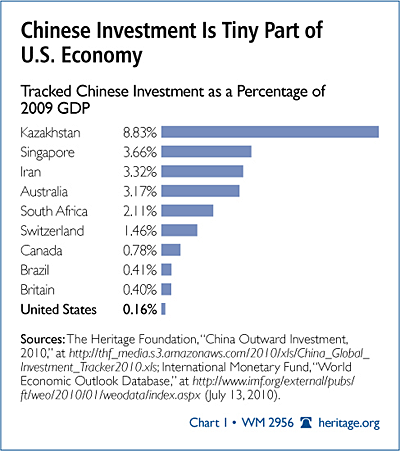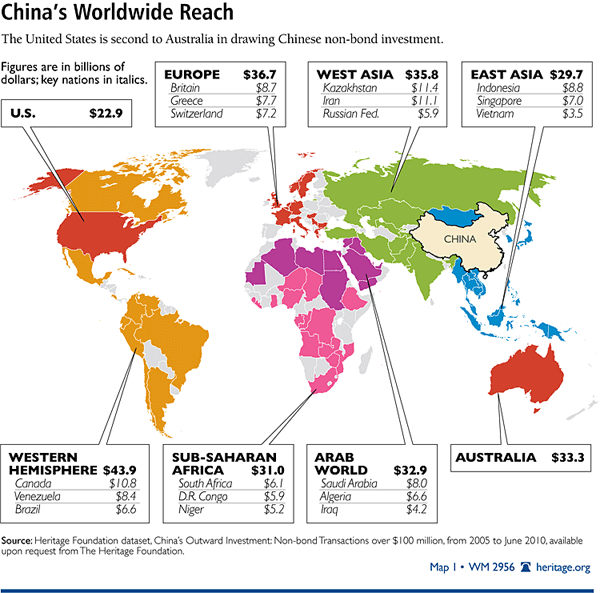The People’s Republic of China invests a great deal of money in the U.S. The Department of the Treasury’s latest tally puts China’s financial stake in America, as of the middle of last year, close to $1.5 trillion, or the equivalent of 12.7 percent of U.S. public debt at the time. Even that figure is too low, since Treasury assigns $650 billion in investment in the U.S. to the Cayman Islands and hundreds of billions to other known thruways for national investors like China.[1]
More is on the way. The PRC’s trade surplus in particular brings dollars that head back to the U.S. as investment. China’s currency rules mean that foreign reserves cannot be used at home. Because reserves are so large—$2.5 trillion and rising—most end up in the one foreign economy large enough to absorb them: America’s.
The strange part is that Treasury’s data indicate that 94 percent of Chinese investment in the U.S. goes to low-yield U.S. government bonds. China has clear interests beyond bonds. The Heritage Foundation’s China Global Investment Tracker documents nearly $200 billion in global spending by Chinese firms outside bonds between January 2005 and June 2010. An additional $130 billion in attempted investment failed for various reasons.[2]
China’s investment in the U.S. is skewed toward the government in part because political opposition has blocked spending outside bonds—investment protectionism. There is certainly a very narrow range of sectors directly important to national security that should be off-limits. Yet most of the political opposition goes well beyond that. Such opposition is not well-considered; the U.S. should accept more non-bond investment.
Losing Out
The Heritage tracker misses small positions in American stocks taken by the two Chinese sovereign funds, the China Investment Corporation and the State Administration of Foreign Exchange. It excludes slowly expanding U.S. lending by Chinese banks. Even granting these omissions, the U.S. receives very little Chinese non-bond investment.
The U.S. is a distant second to Australia in attracting Chinese non-bond investment since 2005, but that is a misleading result. Of the top 10 recipients of investment (which excludes engineering and construction contracts) over that period, the U.S. has drawn by far the least as a percentage of GDP. Moreover, of the other countries below the 1 percent mark, Brazil’s and Canada’s totals are now rising rapidly.

The list of top Chinese investment targets includes countries blessed with sound investment environments, countries with rich natural resources, and a few countries offering both. The U.S.—with coal, natural gas, iron ore, and other natural resources—offers both, yet it draws trivial Chinese investment as compared to annual GDP.
The obvious reason is that all the money goes to bonds. Diversion over time of just 5 percent of Treasury’s (too low) estimate of Chinese bond holdings in June 2009 would cause total non-bond investment in the U.S. to quadruple to $90 billion. Chinese money is pouring into this country—but all to the federal government. This is a very poor way to create jobs, among other things. The misallocation is not due to Chinese investment choices, however, but misguided American political objections.
Dubious Barriers
China’s program to “go out” and acquire overseas assets began in the U.S. The PRC effectively entered the world of modern mergers and acquisitions when Lenovo bought IBM’s personal computer unit in 2004. Its place in that world changed violently when CNOOC was blocked from acquiring Unocal in 2005.
There are sound arguments to restrict Chinese acquisitions. At their core is the dominance in outward investment of arms of the Chinese government and state-owned firms. While more commercial in operation than their ancestors 20 years ago, they are still not commercial entities. They frequently serve the Chinese state’s broad strategic purposes and, in turn, receive huge subsidies when Beijing desires. There is also the prickly issue of reciprocity. With American investment in the PRC heavily restricted, it rankles many to permit Chinese investment in the U.S.
Legitimate and prudent restrictions, however, should not be permitted to morph into knee-jerk reactions that harm American interests. Even in the sensitive area of technology, there have been odd decisions. Bain Capital brought Chinese telecom Huawei in as a small minority partner in its buyout of 3Com because Huawei and 3Com had a non-compete clause. The deal was blocked on national security grounds, but 3Com then partly relocated to China, which seems to be a worse security outcome.[3]
Natural Resources: The Biggest Problem
After the Unocal failure, the PRC turned toward Australia (and now Canada) for natural resource acquisition in a modern regulatory environment. The U.S. is losing investment—or seeing it diverted to government bonds—that would serve a range of national interests. Permitting the PRC to share in American gas production, for example, could improve China’s status as the world’s top air polluter.
The situation has become more striking in the last few months. Over seven weeks in spring 2010, India’s Reliance Industries took two large minority stakes in multi-billion-dollar shale projects in the U.S. Reliance’s spending alone will be in the billions of dollars and exceeds all Chinese non-bond investment commitments from January to June and the historical total for all Chinese investment in American mineral resources. Meanwhile, China’s Anshan Iron faces political objections to acquiring a small minority stake in a $200 million steel plant.[4]
Reliance’s plans have, properly, elicited no response, but the Congressional Steel Caucus charges that the Anshan deal will subvert American security. This is nothing short of outrageous. Secretary of State Hillary Clinton, among others, has rightly called unprecedented deficit spending a true national security threat, while Congress and the Administration are unable to stop themselves from borrowing $1.5 trillion from the PRC. Yet $15 million or so in a steel plant that will actually create jobs is the target of congressional ire.
Better American Policy
Some deals involving Chinese enterprises do go forward. No complaints have been made to date against General Motors’ sale of its Nexteer Automotive unit to a joint venture between Chinese auto parts supplier Tempo and the Beijing municipal government for approximately $400 million. But if a tiny steel investment threatens national security, why not a much larger auto investment? Chinese investors and their American partners have to guess where political lines are, which is the antithesis of a sound business environment.
The first policy step must be to remove confusion caused by ongoing and haphazard political interference. Because most Chinese investment in the U.S. is made by state-owned entities, it will be reviewed by the Committee on Foreign Investment in the U.S. (CFIUS). Restrictions beyond CFIUS at the sector level, such as in transportation, should be examined by the Departments of Defense and Treasury to ensure they have a genuine national security purpose and removed if they do not. Purely political opposition should not be permitted to derail Chinese investment, and the large bulk of the economy should be open, with clear and consistent regulations.
Long-Term Solutions: Treaty Needed
For the long term, depoliticized and reciprocal investment access can be protected only by a proper bilateral investment treaty. Negotiating one will be a difficult and lengthy process due to the non-commercial operation of Chinese state enterprises. However, in addition to making many needed demands on Beijing, the U.S. should be able to offer transparent access to most of the American market. Such an outcome will prove a useful diplomatic tool and, more importantly, will help the American economy.
Derek Scissors, Ph.D., is Research Fellow in Asia Economic Policy in the Asian Studies Center at The Heritage Foundation.



